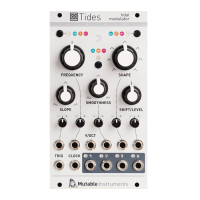A. Mode switch. This button cycles back and forth between Tides’ 3 operation modes: AD envelope
(green LED), cyclic (LED off) and AR envelope (red LED). Note that a trigger pulse (or gate) must be sent
to the TRIG input for the AD envelope (or AR envelope) to be triggered!
B. Range switch. This button cycles back and forth between Tides’ 3 frequency ranges: low (20 minutes
to 5 Hz - green LED), medium (0.05 Hz to 300 Hz - LED off), and high (8 Hz to 10kHz - red LED). Note
that the “high” mode is optimized for audio frequencies and that the shape/slope settings have a different
response curve optimized for this. Read the “Time domain vs frequency domain” section for some
enlightenment!
C. Main frequency control. This knob has a range of +/- 4 octaves. The output bicolor LED next to this
knob reflects the amplitude of the generated waveform. The LED is green in the attack phase, and red in
the decay, sustain and release phases.
D. FM input attenuverter. This knob controls the polarity and amount of frequency modulation from the
FM input (7). When no patch cable is connected to this input, a 0.1V constant signal is internally switched
there, causing this knob to behave like a fine frequency control.
E. Shape control. This knob adjusts the shape of the wave - providing different combinations of
curvatures for the rise and fall segments.
F. Slope control. This knob adjusts the balance between the rise and fall time. When turned fully counter-
clockwise, the rise time is null and the decay segment takes up the whole duration of the cycle (decaying
envelope). When turned fully clockwise, the attack segment takes the whole duration of the cycle and the
fall is immediate. Both phases have equal duration when the knob is at 12 o’clock.
G. Smoothness control. When set at 12 o’clock, the waveform produced by the waveshaper is output
without any modification. Turn the knob counter-clockwise, from 12 o’clock to 7 o’clock to progressively
attenuate the high-frequency content of the signal (2-pole low-pass filtering). Turn the knob clockwise,
from 12 o’clock to 5 o’clock to progressively enrich its high-frequency content through wavefolding.
1. 2. 3. Shape, Slope, Smoothness CV inputs. The Shape/Slope/Smoothness knobs act as offsets
added to these inputs.
4. Gate/Trigger input. In cyclic mode, sending a pulse to this input simply resets the phase of the
oscillator. In AD and AR modes, this signal is the trigger/gate driving the envelope. The detection
threshold is 0.7V.
5. Freeze input. Whenever the signal on this input is high, the oscillator or envelope stops in its tracks -
until the input is back to 0V. The detection threshold is 0.7V.
6. V/Oct frequency input. Tides is digital and tracks well. If it does not, head to the “Calibration” section
to fix this!
7. FM input. The signal on this input is attenuverted by (D).
8. LEVEL input. This input acts as a VCA to scale the UNI and BI outputs (input range: 0V to 8V - higher
voltages tolerated and clipped). This input is normalled to a constant 8V signal - causing the UNI and BI
outputs to have a full amplitude when no patch-cord is connected to this input.
9. CLOCK input. The oscillator frequency or AD/AR cycle time can be synchronized to an external digital
signal (detection threshold of 0.7V). More about this in the “Clocked/PLL mode” section.
10. High-tide output. This output goes high (+5V approx.) at the end of the attack phase, and stays at
this level until the cycle restarts or the envelope is retriggered.
11. Low-tide output. This output goes high (+5V approx.) at the end of the decay/release phase, and
stays at this level until the envelope is retriggered. Both High-tide and Low-tide outputs can be used to
chain envelopes.
12. 13.Unipolar and bipolar outputs. The unipolar output has a 0..8V range, and the bipolar output a +/-
5V range. Beware! These outputs have a very different shape - it is not simply a matter of scale and offset
- after all, there are CV-processor utility modules for getting an unipolar wave from a bipolar wave and
vice-versa!

